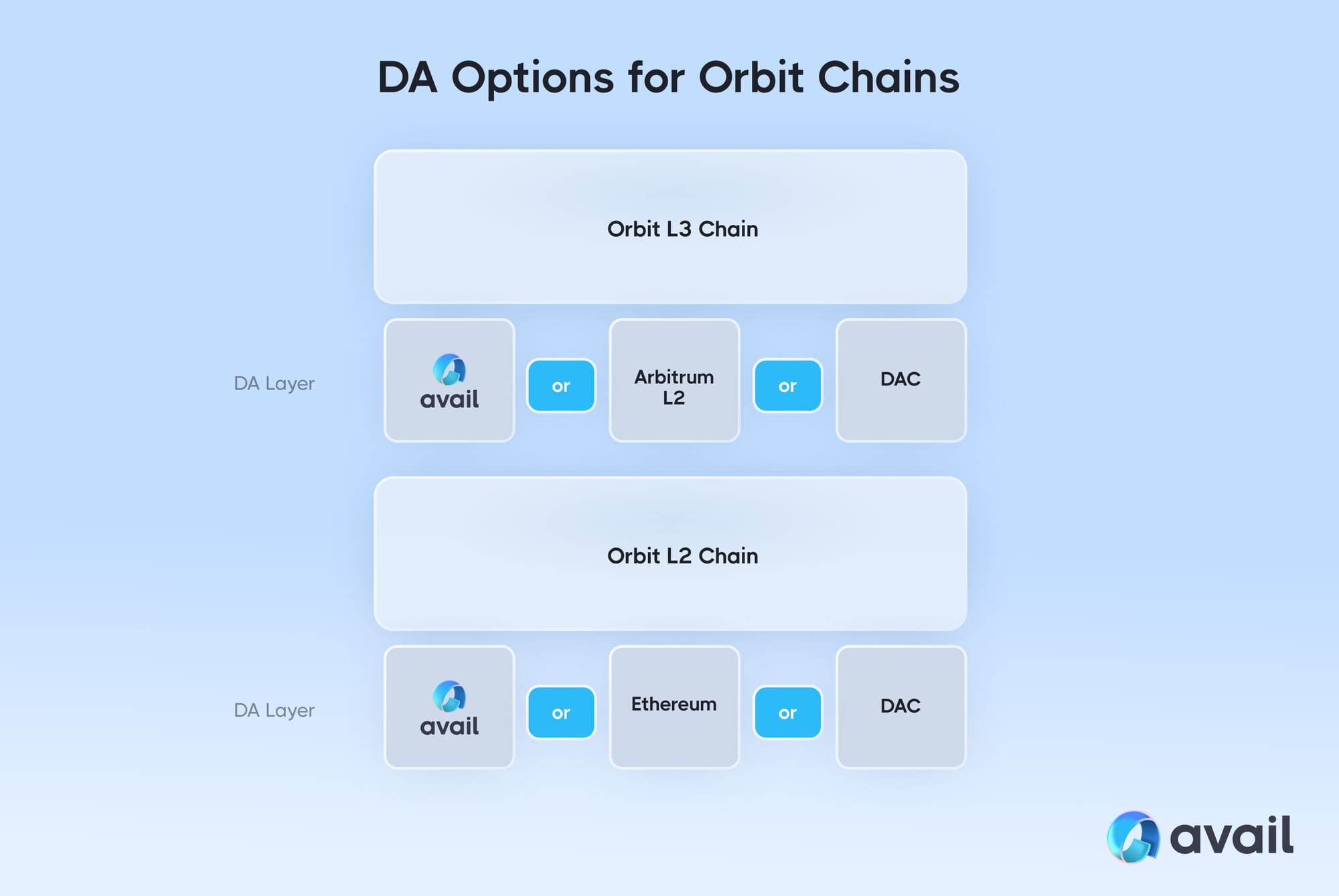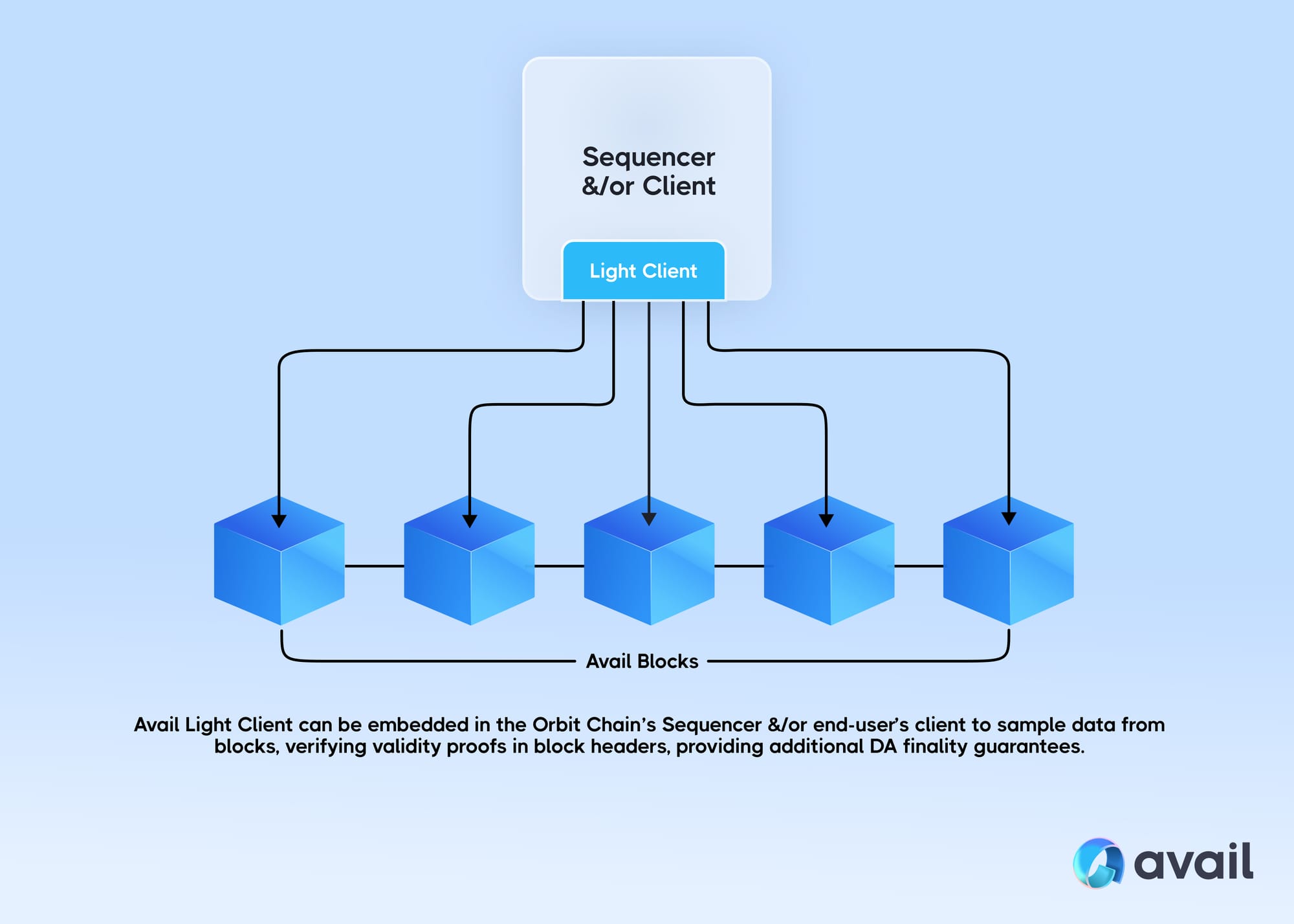TL;DR
- Arbitrum Orbit Chains get validity proof based data availability guarantees when integrating with Avail DA.
- Arbitrum Orbit Chain developers can access the same technology earmarked in Ethereum’s Danksharding roadmap today when they use Avail DA.
- Arbitrum Stylus, Arbitrum Orbit and Avail DA combine to enable powerful, low-cost and scalable chains.
- Learn how to integrate Arbitrum Orbit Chains with Avail DA.
Arbitrum Orbit Chains with Avail DA
Developers have started utilizing Arbitrum’s Nitro rollup stack which has been battle tested by hundreds of apps and millions of users on Arbitrum One. Arbitrum Orbit Chains provide developers with the tools they need to use the Arbitrum Nitro stack for their own blockchain apps. Now Orbit developers can plug right into Avail DA, and spin up a decentralized blockchain in minutes. This allows devs to focus on adding features and acquiring users instead of setting up & optimizing infrastructure!
Developers building Arbitrum Orbit Chains can build dedicated app-specific, or general purpose blockchains, customize privacy, permissions, fee token, governance, and more. This provides a blank canvas for developers looking to explore custom web3 apps.
Developers less familiar with native web3 programming languages, like solidity, will soon be able to leverage Arbitrum Stylus which enables smart contracts to be written in programming languages that compile down to WASM, starting with Rust, C, C++, and a whole lot more to come.
With Avail’s DA Layer at the base, anything can be supported on top, including Arbitrum Orbit Chains and developers get to inherit Avail DA’s full feature set upon integration.
Let’s see how using an Orbit chain with Avail DA compares with using Ethereum, another Arbitrum L2 or the AnyTrust Protocol for Data Availability.

What is Avail DA?
Avail DA is a foundational DA layer and the first step towards a unified web3. It implements the same technology earmarked in Ethereum’s Danksharding roadmap. It’s a validity proof based data availability layer optimized for securing blockchains and providing mathematically verifiable DA guarantees to all of its users. Avail’s blocks provide raw blockspace for the data availability needs of other blockchains such as Arbitrum Orbit chains.
Avail’s modular blockchain prioritizes decentralization with a nominated proof-of-stake design. Utilizing the Polkadot SDK, Avail will have the ability to support up to 1,000 external validators. Transaction data is published on Avail’s blocks by other blockchains and validated by the Avail network (but not executed, as that’s what the execution layer is for).
Avail began inside Polygon in 2020 and became a separate entity in 2023. The team is led by Polygon’s co-founder Anurag Arjun and former Polygon research lead Prabal Banerjee and is set up to provide an industry leading data availability solution.
Data Availability with the Arbitrum AnyTrust Protocol
The AnyTrust protocol is used by Arbitrum Nova (L2) and L3 Orbit AnyTrust chains. The AnyTrust protocol manages DA through a permissioned set of parties known as a Data Availability Committee (DAC).
When using the AnyTrust protocol, transactions are submitted to the sequencer, where a batch is created and sent to DAC members. The DAC is made up of N members (at the time of writing, the Nova DAC consists of 7 members), of which the AnyTrust protocol assumes that at least 2 are honest.
Upon receiving the transaction batch, DAC members sign the batch and return their signatures with a success indicator to the sequencer. Once the sequencer has received enough signatures from DAC members, it creates a Data Availability Certificate (DACert). The AnyTrust protocol uses the DACert as a promise that the block's data will be available, until at least the expiration time. This is done under the assumption that at least one of the promising parties is honest. The sequencer will then post the DACert to the L1 &/or L2.

Data Availability for Arbitrum Orbit L3s using Arbitrum L2
An Arbitrum Orbit L3 using the Arbitrum Rollup Protocol to manage Data Availability will send a transaction batch from the L3 sequencer to the inbox contract of the Arbitrum L2 chain.
The Arbitrum L2 sequencer will then order the batch submission transaction from the L3, along with others in its inbox.

Data Availability for Arbitrum Orbit Chains with Avail DA
Like today, transactions would get submitted to the Orbit Chain’s sequencer and a batch would be sent to Avail DA. Once the data is received by Avail DA it goes through Avail’s standard process.
The data is extended through erasure coding. This adds redundancy and makes it harder for nodes to suppress the data. Avail then generates two attestations for validation, and to ensure the data has a footprint in the block’s header. One being KZG polynomial commitments of the submitted data and the other, the ‘data root’ which is the root of the Merkle tree whose leaves are the data blobs submitted.
Once a supermajority of the Avail validators have agreed on a block, it is finalized using the GRANDPA finality gadget. At this point, the data availability is guaranteed by Avail. The data root is used by the sequencer to show proof of inclusion of posted data within a finalized block.

For AnyTrust chains, they can use Avail’s data availability layer instead of a DAC which significantly reduces the trust assumptions and improves the blockchain’s decentralization guarantees.
Arbitrum Orbit L3’s that send transaction data to the L2 sequencer can instead post transaction data to Avail DA. The L3’s sequencer can then send the data root it receives from Avail DA to the L2’s sequencer, providing significant improvements in the DA guarantees offered by the L3 chain.
Data Attestation Verification
For transaction settlement and finalization it’s important that the settlement layer has both a proof of execution (which is handled by the Arbitrum Orbit Chain) as well as a proof of data availability.
Data attestations serve as proof on the L2 or L1, that Avail’s validators have reached consensus on the data's availability. To achieve this, the Vector Data Attestation Bridge relays the data root from finalized blocks on Avail DA to a specific bridge contract on the target chain.


Mathematically Verifiable DA guarantees with Avail’s Light Clients
Avail uses validity proofs in its construction to verify that data in the Avail network is secure and available. Avail light clients enable the user to mathematically verify the data availability guarantees without an honest majority assumption.
The Avail Light Client has the ability to sample data from the Avail blockchain and could be embedded in the Orbit Chain’s sequencer, Validator or even the end-user’s client. Doing so provides the ability to independently verify that data for the Orbit chain is being made available on Avail without having to trust any other party.
While this is an entirely optional improvement for added verification, implementation would be relatively straightforward. The chain’s transaction data is indexed via a dedicated AppId in Avail. Using the AppID, the Light Client can then sample data from the blocks and validate proofs contained in the block’s header.

Unleashing powerful networks of Arbitrum Orbit Chains with Avail DA
Arbitrum Orbit Chains can start sending transaction data to Avail’s secure, low-cost and decentralized DA layer on the Turing testnet today and on Avail’s mainnet in the coming weeks. This provides the Arbitrum ecosystem with an opportunity to leverage Avail’s DA layer which is capable of guaranteeing an entire ecosystem of L3 Orbit chains.
While this post focussed on Arbitrum Orbit Chains, Avail’s general purpose DA layer integrates with any rollup layer providing a unified experience to end users of any ecosystem.
To learn how to integrate Arbitrum Orbit Chains with Avail DA, check out the Avail Documentation and follow us on X for more.


